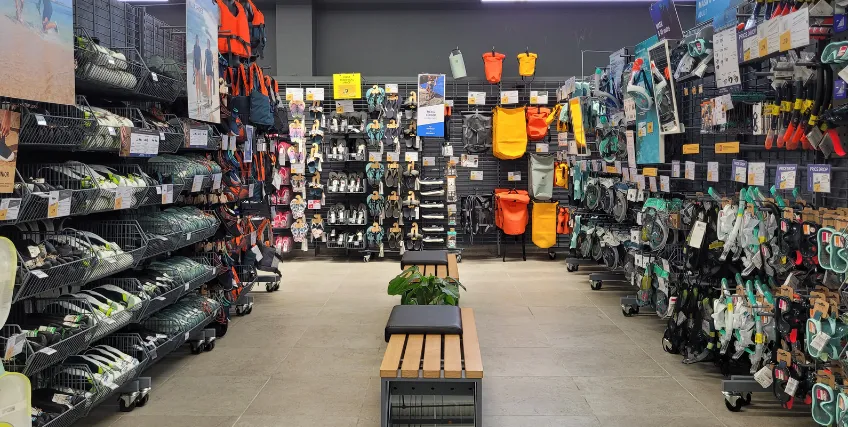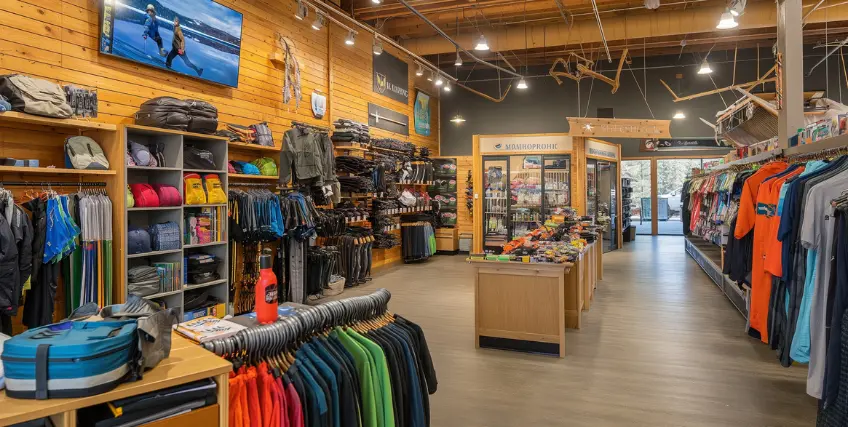Seasonal Sporting Goods Business: Here’s How to Manage Cash Flow with a Loan
April 20, 2025 | Last Updated on: April 21, 2025

As a small business owner, imagine that your sporting goods store is thriving, stocked with top-quality sportswear and athleisure apparel that's flying off the shelves. Customers love your products, and sales are steady year-round. Yet, despite booming sales during peak seasons like the holiday season, you encounter cash flow challenges, particularly during slower periods or off-peak seasons.
In this article, we will discuss the sporting goods industry and how different types of financing options can help sporting goods businesses efficiently manage cash flow issues and maintain stable growth.
Understanding the Sporting Goods Industry and Its Cash Flow Challenges
The sporting goods industry offers a wide range of products, including athletic equipment, apparel, e-commerce athleisure lines, and even specialized gear for ski resorts and landscaping activities. According to Statista (2024), the sporting goods industry in the U.S. generated approximately $70 billion in revenue last year alone, reflecting steady growth driven by consumer enthusiasm for fitness, outdoor activities, and fashionable yet functional athleisure wear.
However, small business owners in this industry regularly encounter specific cash flow challenges. Seasonal fluctuations often mean busy seasons with strong cash inflow followed by slower periods, causing liquidity shortages. Here, inventory management can tie up significant amounts of working capital, especially when stocking new products for peak periods.
Additionally, delays in receivable collections, unfavorable payment terms, and unexpected operational costs contribute to frequent cash flow challenges. Hence, effective cash flow management thus becomes critical to ensuring enough cash reserves to cover all business needs throughout the year.
Financing Options Available to Sporting Goods Businesses
Sporting goods companies have several financial solutions to mitigate cash flow problems. Choosing the appropriate financing method should be guided by careful cash flow forecasting, considering historical data and anticipated revenue streams.
Here are some to explore for top sporting goods retailers without disrupting their cash flow:
- Term Loans: These loans offer fixed repayment schedules with predictable interest rates for sporting goods businesses. Also, these are ideal for major investments or inventory purchases.
- Business Lines of Credit: These lines of credit provide flexibility by allowing sporting goods businesses to borrow as needed by paying interest only on the borrowed amount. This financing option is ideal to manage short-term cash flow gaps and seasonal business fluctuations.
- Inventory Financing: This loan option specifically helps retailers finance inventory purchases without tying up too much cash, especially beneficial during peak seasons.
- Invoice Factoring: Invoice factoring converts unpaid invoices into immediate cash, ensuring faster access to funds and addressing short-term liquidity shortages.
- No Credit Check Financing: This financing option is ideal for sporting goods businesses facing immediate financial needs but lacking established credit histories. This offers swift access to necessary capital without stringent credit checks. Examples include merchant cash advances, payday loans, and certain online lending platforms prioritizing quick approval processes.
Managing Cash Flow in Your Sporting Goods Business with Loans
As a small business owner, if you’re seeking financing for your sporting goods business, these can significantly help you enhance cash flow stability. Here's how sporting goods businesses can utilize financing effectively:
Improved Inventory Management
Loans allow sporting goods businesses to buy inventory in bulk, reducing costs, and freeing cash reserves for other operational expenses. Not only this, but strategic inventory financing also ensures availability during peak times that helps in minimizing lost sales opportunities.
Additionally, this reduces overhead and optimizes your cash flow, keeping your business resilient through seasonal fluctuations. For instance, a small business that specializes in premium athleisure might use inventory financing to stock up before the busy holiday season. This helps them to ensure product availability without exhausting current cash flow.
Stabilizing Seasonal Cash Flow
Seasonal businesses often face off-season cash flow issues. To deal with this situation, a line of credit or a short-term loan can provide necessary funds during these slower months. This will help you to cover staffing costs and operational expenses, thus ensuring seamless operations year-round.
Let’s understand this, a sporting goods company with peak periods during back-to-school seasons can rely on a line of credit during slow seasons. How will this help the business? It will help to maintain consistent staffing levels and ensure uninterrupted customer service.
Managing Operational Costs
What is the most important factor in running a sporting goods business? It’s the operational cost. Regular operational expenses continue regardless of revenue fluctuations. To operate the business without any disruption, loans provide necessary liquidity. Therefore, these loans can be used to manage payroll, utilities,and rent during periods of reduced cash inflow.
This proactive approach not only helps in preventing operational disruptions, but also helps in maintaining employee morale, and ensuring continuous business activities without financial strain.
Leveraging New Product Incentives
One of the other important advantages of seeking financing for sporting goods businesses is that business loans enable retailers to capitalize on incentives. These can be used for launching new product lines, attracting additional customers, and diversifying revenue streams.
Also, expanding into sustainable sportswear or innovative fitness gadgets can significantly boost profitability and market share. As one of the top sporting goods retailers, you might use a business loan to introduce a new line of eco-friendly athletic gear. This can help you in tapping into the growing consumer demand for sustainable products and expanding their market reach.
Enhancing Strategic Planning and Liquidity
When running a sporting goods business, it is important to have effective cash flow projections and strategic financial planning for growth. You can utilize small business loans responsibly to boost liquidity, improve overall cash flow management, and position the business favorably for future lending by enhancing creditworthiness.
If you regularly update cash flow forecasts and align loan repayments accordingly, this can demonstrate your financial responsibility to lenders. As a result, this will help you to secure better terms on future loans.
Optimizing Repayment Strategies
If you’re taking a loan for your sporting goods business, these should be strategically managed with clear repayment plans. Hence, the loans should be aligned with your business’s cash flow forecast. It is always better to regularly review your repayment schedules against actual cash inflows to ensure adjustments are timely and effective.
However, if your sporting goods store is experiencing higher-than-expected seasonal sales, you can allocate extra cash inflows to repay loans faster. This will surely help you in reducing the overall interest costs.
Expanding Through Strategic Investments
It is important to understand that loans provide capital to strategically invest in business expansion. These can be either through new locations or enhanced e-commerce capabilities.
The new expansions can help you diversify income sources, stabilize revenue streams, and reduce dependency on seasonal trends. Additionally, you can use loan funds to upgrade an e-commerce platform to enhance online sales, especially beneficial during slower physical-store traffic periods.
Implementing Technology for Efficiency
Small business owners need to invest in the latest technology. This can be easily done by seeking financing for their business. With the help of loans, they can easily streamline inventory tracking, automate invoicing, and enhance overall cash flow management. These advancements in return help to improve operational efficiency, reduce errors, and ultimately increase profitability.
For this, business owners can adopt advanced inventory management software using loan funds to accurately track stock levels and reduce the overall risk of overstocking or shortages of products.
Enhancing Marketing Efforts
Utilizing the right loans for your sporting goods business can help you fund strategic marketing initiatives, such as targeted digital campaigns, seasonal promotions, and customer loyalty programs. These investments will drive customer engagement, boost sales during peak seasons, and sustain revenue during slower months.
So, if you’re running a targeted digital campaign funded by a business loan, it can effectively attract more customers during traditionally slower sales periods, boosting overall revenue.
Emergency Funding Preparedness
What would you do if your business needed emergency funding? During this tough period, having access to quick financing options can help your business to tackle unexpected expenses. These loans can be used for emergencies which will safeguard your operational continuity and financial stability.
Quick access to emergency funds allows small business owners to swiftly address unexpected expenses like equipment repairs or urgent inventory replenishments without disrupting regular business operations.
Conclusion
Managing cash flow effectively is one of the crucial factors for sporting goods businesses, facing seasonal fluctuations and operational expenses. To manage cash flow effectively, small business loans can help bridge the gap between busy and slow periods. This will ensure stable operations, robust financial health, and strategic growth.
If you’re ready to overcome your cash flow challenges in your sporting goods business, explore different types of financing options today and secure your sporting goods business’s financial future.
Frequently Asked Questions About Sporting Goods Businesses
Why do sporting goods businesses commonly face cash flow issues?
Sporting goods businesses often face cash flow challenges due to seasonal fluctuations, inventory management demands, delayed receivables, and variable operational costs. However, businesses experience peaks during busy seasons (like holidays or back-to-school periods) and slow cash inflows during off-peak times, causing liquidity constraints.
What are some examples of no credit check financing options available for sporting goods businesses?
Some examples of no credit check financing include options like merchant cash advances, payday loans, and certain online lenders offering quick loan approvals. These financial solutions are helpful if your business needs immediate funds but lacks an established credit history or faces urgent cash flow needs.
How can sporting goods businesses benefit from inventory financing?
Inventory financing specifically addresses cash tied up in inventory by providing funds to purchase stock without draining available cash reserves. It allows businesses to keep shelves stocked, particularly ahead of peak seasons, without restricting the working capital needed for other operational costs.
What role does cash flow forecasting play in managing loans?
Cash flow forecasting involves estimating future cash inflows and outflows using historical data and market trends. Also, accurate forecasts enable businesses to strategically plan loan repayments, optimize financing decisions, and prepare effectively for seasonal fluctuations or unexpected costs.
How does invoice factoring assist cash flow management?
Invoice factoring converts outstanding invoices into immediate cash by selling receivables to factoring companies at a discounted rate. This provides quick access to funds, reducing liquidity shortages and improving your sporting goods business's ability to handle immediate expenses.




